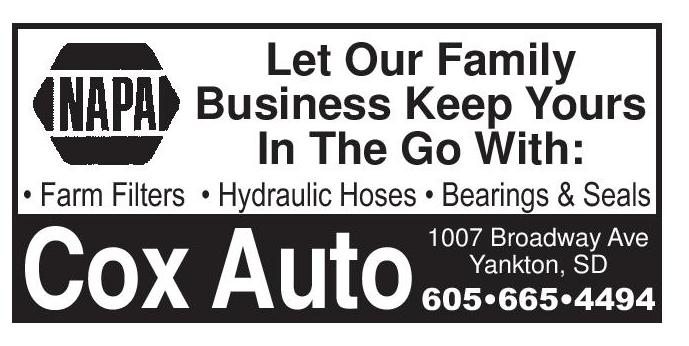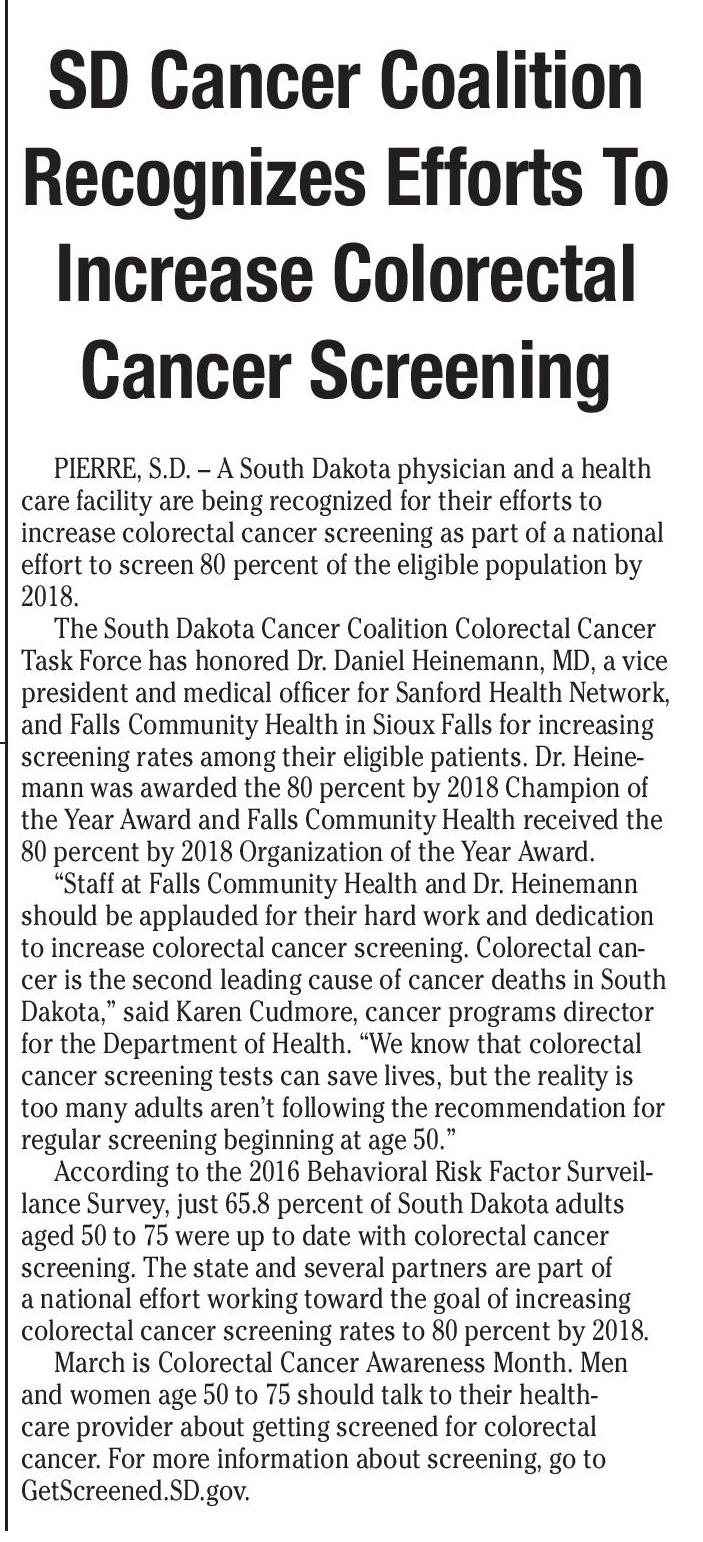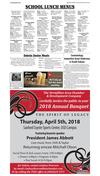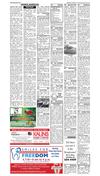032718_YKBP_A8.pdf







March 27, 2018 www.broadcasteronline.com
8 Broadcaster Press
Feed at Night, Calve
During the Day
BROOKINGS, S.D. - Does feeding time influence the
time of calving? To answer this question, SDSU Extension
Cow/Calf Field Specialists Adele Harty and Taylor Grussing look to research data.
"Yes, feeding affects time of calving," Harty said.
"Feeding cows later in the day and evening will increase
the number of calves born during daylight hours, when
it is easier for livestock producers to watch them more
closely."
Gus Konefal, a rancher from Manitoba, Canada first
developed this feeding method after he discovered 80
percent of his cows calved between 7 a.m. and 7 p.m.
when they were fed later in the day.
Konefal's method included a twice a day feeding, with
first feeding between 11 a.m. and noon and second feeding between 9:30 p.m. to 10 p.m.
Supporting Research
Similar research was conducted at Iowa State University.
"This research used the Konefal feeding system, but
only feeding one time per day at 4 p.m., starting two
weeks prior to the expected start of calving," Grussing
said.
The result? Eighty-two percent cows calved between
6 a.m. and 10 p.m. with 91 percent of the calves born
before 11 p.m.
"Only 9 percent of calves were born outside the window when traditional calf checks are performed," Harty
said.
When heifers were separated from the data set and
analyzed, 90 percent calved in this same time frame.
A survey collected from 15 beef producers in Iowa
and Missouri also reported that when they fed once
daily between, 5 p.m. and 10 p.m., the result was 85 percent of cows calving between 5 a.m. and midnight.
Compare this data to cows from herds not on the
Konefel feeding system. That data showed an equal distribution of cows calving during the night as during the
day, a 50/50 split.
Researchers at USDA-ARS at Miles City, Montana
completed at three-year study evaluating differences in
feeding time on calving time.
"The numbers were not as dramatic as Konefel and
Iowa State data," Grussing said. "However, there was a
consistent 10 to 20 percent decrease in the number of
cows calving between 10 p.m. to 6 a.m. in the late fed
cows compared to the early fed cows."
Management Considerations
If you're a cattle producer who would like to see
more calves born during daylight hours, below are some
Noem: Supporting Moms,
Strengthening Families
By Rep. Kristi Noem
South Dakota has the nation’s
highest rate of working moms with
84 percent being employed outside
the home. For many families, both
parents working is a financial necessity – one that comes with significant
child care costs attached. In fact, by
some estimates, child care in South
Dakota costs about 28 percent of the
average household income, or about
$14,700 per year.
Many of these families qualify for
the Child and Dependent Care Tax
Credit, which helps defray some
child care expenses. During tax
reform, however, some in Congress
tried to eliminate the benefit. I had
to fight hard to maintain the credit,
but in the end, we were successful.
Additionally, the Child Tax Credit
was doubled to $2,000 per child, a
win I worked closely with Ivanka
Trump to achieve. These credits can
make a real difference in people’s
lives.
A few weeks ago, I spoke with a
single mom who is getting another
$80 every pay check because of tax
reform. For her, that meant she had
more breathing room and greater
financial security. For her son, it
meant a new pair of basketball
shoes.
I’ve heard similar reports from
others. Let’s say you’re a family of
four making around $85,000 a year.
Because of tax reform, you’ll be
keeping an additional $2,400 in your
pocket every year. That’s a new
washing machine, a nice family vacation, or a good chunk of change for
the kids’ college funds.
Of course, this financial peace of
mind helps mitigate only one of the
challenges working families face.
Flexibility is another issue I’ve heard
a lot about. For years, I’ve been
working to get the Working Families
Flexibility Act signed into law to help
make balancing the demands of family, personal responsibilities, and the
workforce a little easier.
This bill would give employees
the opportunity to choose between
taking overtime pay or receiving
more paid time off. I’ve led the
House in passing this bill multiple
times, the most recent being in 2017,
but the Senate has yet to consider
the bill.
Additionally, in March of this
year, I introduced legislation to help
give expectant mothers additional
flexibility, when needed. In the early
2000’s, Peggy Young was working
for UPS. She became pregnant and
was instructed not to lift anything
over 20 pounds. She requested lightduty work, but was told “No,” even
though accommodations were made
for non-pregnant workers that had
similar health-related restrictions.
She couldn’t return to her previous
role either, as it was a liability.
As a result, Peggy had to go on
unpaid leave and lost her medical
coverage. She filed a lawsuit against
UPS, which has since changed its
policy, but the court’s decision left
a lot of questions. My bill works to
clarify the law. It says a pregnant
worker should be treated the same
as a non-pregnant worker who may
have a temporary disability and is
therefore unable to perform certain
duties. This bill takes a balanced approach, protecting mothers without
imposing duplicative burdens on
their employers.
I firmly believe our nation would
be a whole lot stronger, if families
were a whole lot stronger. Supporting working parents is an important step in achieving that. When
we make these investments, we
strengthen families and put the next
generation on a trajectory toward
success.
points to consider when implementing the Konefal calving method.
1. Research indicated for this method to be most
effective, evening feedings should be implemented one
month prior to the scheduled start of calving. If feeding
times are changed closer to calving, this will result in a
more calves born during the day than morning feeding.
2. Iowa State University data advises staying as close
to the same feeding schedule and feed amount as possible each day. Deviating more than 15 minutes, or providing too much feed, will yield less desirable results.
3. Maintain regular night checks. Konefal calving may
simply mean that there will be less work to be done between checks due to fewer calves born during the night.
4. The Konefal calving method works best in a drylot
situation where all feed is provided. Desired effect in a
grazing situation may not be seen unless supplemental
hay or timing of grazing can be regulated.
5. Weather can play a role in effectiveness. Before or
during storms, cattle may not come to the bunk to eat
and may be more likely to calve at night.
6. Additional research indicates that a first calf heifer
who calves during the day will tend to calve during the
day the remainder of her productive years.
Turn Yo ur Clutter
i
nto Cash!
Advertise your Garage Sale to
thousands of readers!
624-4429
SD Cancer Coalition
Recognizes Efforts To
Increase Colorectal
Cancer Screening
PIERRE, S.D. – A South Dakota physician and a health
care facility are being recognized for their efforts to
increase colorectal cancer screening as part of a national
effort to screen 80 percent of the eligible population by
2018.
The South Dakota Cancer Coalition Colorectal Cancer
Task Force has honored Dr. Daniel Heinemann, MD, a vice
president and medical officer for Sanford Health Network,
and Falls Community Health in Sioux Falls for increasing
screening rates among their eligible patients. Dr. Heinemann was awarded the 80 percent by 2018 Champion of
the Year Award and Falls Community Health received the
80 percent by 2018 Organization of the Year Award.
“Staff at Falls Community Health and Dr. Heinemann
should be applauded for their hard work and dedication
to increase colorectal cancer screening. Colorectal cancer is the second leading cause of cancer deaths in South
stream rehabilitation efforts.
Dakota,” said Karen Cudmore, cancer programs director
“Custer State Park is truly a gem
for the Department of Health. “We know that colorectal
for the entire state of South Dakota,” cancer screening tests can save lives, but the reality is
said Walter Panzirer, a trustee for
too many adults aren’t following the recommendation for
the Helmsley Charitable Trust. “The regular screening beginning at age 50.”
Helmsley Charitable Trust has alAccording to the 2016 Behavioral Risk Factor Surveilready made significant investments
lance Survey, just 65.8 percent of South Dakota adults
in the park, providing funding for
aged 50 to 75 were up to date with colorectal cancer
the theater in the visitor center and screening. The state and several partners are part of
the remodel of the Peter Norbeck
a national effort working toward the goal of increasing
Outdoor Education Center. We are
colorectal cancer screening rates to 80 percent by 2018.
pleased to assist with strategic efMarch is Colorectal Cancer Awareness Month. Men
forts to mitigate the effects of the
and women age 50 to 75 should talk to their healthdevastating fire and ensure visionary care provider about getting screened for colorectal
steps are taken to secure the park
cancer. For more information about screening, go to
for future generations.”
GetScreened.SD.gov.
Helmsley Charitable Trust Grants $1.8 Million to
Support Custer State Park Fire Rehabilitation Project
Custer State Park, S.D. – The
Leona M. and Harry B. Helmsley
Charitable Trust has awarded a $1.8
million grant to Custer State Park to
aid rehabilitation efforts following
last December’s Legion Lake Fire.
The fire burned nearly 50 percent
of Custer State Park’s 71,000 acres
and is the third largest fire in Black
Hills recorded history.
“The Legion Lake Fire took us all
by surprise and could have been
much, much worse, if not for the
hard work and heroic efforts of
our firefighters,” said Gov. Dennis
Daugaard. “It was South Dakota at its
best; people from across the state
and region pulled together in a time
of need. And that hard work continues through rehabilitation efforts
with help from The Leona M. and
Harry B. Helmsley Charitable Trust.
By peak season, park staff will have
the park in pristine condition, ready
to give visitors the high-quality
experience they have provided for
decades.”
The grant funds will be put to
immediate use extending over a
three-year period to support aerial
mapping, tree thinning, reseeding,
weed control, erosion control and
CO
CO
CANADAY Sale
40th Annual “Pride in Performance”
p.m.
F-1 to purebreds all Percentages
Simmental, SimAngus, Angus
22
5
SONS
SELL!
He is an
industry
leader!
8 Bred Heifers
Let Our Family
Business Keep Yours
In The Go With:
Cox Auto
1007 Broadway Ave
Yankton, SD
OTHER SIRES
KCF Bennett
Absolute
AAA16430795
GCC-7
Absolute
Brilliance
Bruiser
Complement
Yellowstone
contact:
David Canaday
Kathleen Canaday
89287 543 Ave.
Bloomfield, NE 68718
54289 893 Rd.
Bloomfield, NE 68718
Phone: 402-373-4482
Curt Robinson
Financial Advisor
Patrick M Higgins
Financial Advisor
23 Market Street
Vermillion, SD 57069
605-624-2028
www.edwardjones.com
7 W. Cherry Street
Vermillion, SD 57069
605-658-0205
www.edwardjones.com
Member SIPC




















 Previous Page
Previous Page






